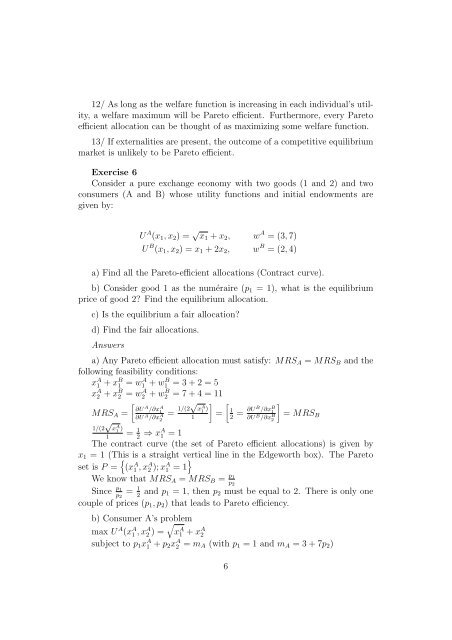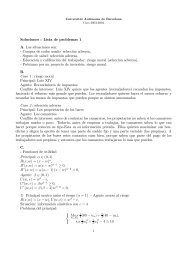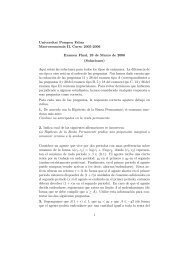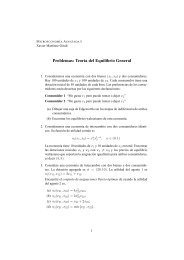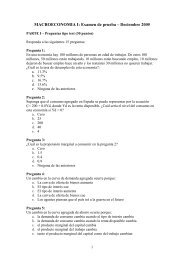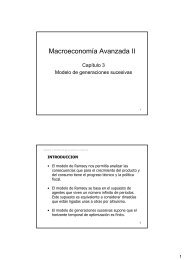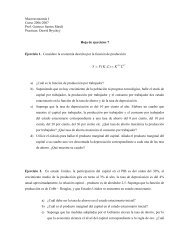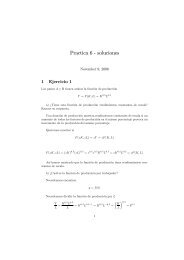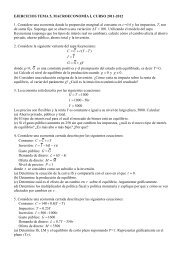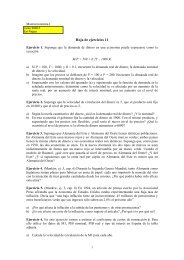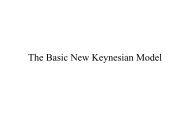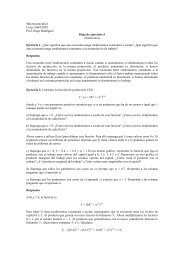Exercise 1 A monopolist has an inverse demand curve given ... - IDEA
Exercise 1 A monopolist has an inverse demand curve given ... - IDEA
Exercise 1 A monopolist has an inverse demand curve given ... - IDEA
Create successful ePaper yourself
Turn your PDF publications into a flip-book with our unique Google optimized e-Paper software.
12/ As long as the welfare function is increasing in each individual’s utility,<br />
a welfare maximum will be Pareto efficient. Furthermore, every Pareto<br />
efficient allocation c<strong>an</strong> be thought of as maximizing some welfare function.<br />
13/ If externalities are present, the outcome of a competitive equilibrium<br />
market is unlikely to be Pareto efficient.<br />
<strong>Exercise</strong> 6<br />
Consider a pure exch<strong>an</strong>ge economy with two goods (1 <strong>an</strong>d 2) <strong>an</strong>d two<br />
consumers (A <strong>an</strong>d B) whose utility functions <strong>an</strong>d initial endowments are<br />
<strong>given</strong> by:<br />
U A (x 1 , x 2 ) = √ x 1 + x 2 , w A = (3, 7)<br />
U B (x 1 , x 2 ) = x 1 + 2x 2 , w B = (2, 4)<br />
a) Find all the Pareto-efficient allocations (Contract <strong>curve</strong>).<br />
b) Consider good 1 as the numéraire (p 1 = 1), what is the equilibrium<br />
price of good 2 Find the equilibrium allocation.<br />
c) Is the equilibrium a fair allocation<br />
d) Find the fair allocations.<br />
Answers<br />
a) Any Pareto efficient allocation must satisfy: MRS A = MRS B <strong>an</strong>d the<br />
following feasibility conditions:<br />
x A 1 + x B 1 = w1 A + w1 B = 3 + 2 = 5<br />
x A 2 + x B 2 = w2 A + w2 B = 7 + 4 = 11<br />
MRS A =<br />
√<br />
1/(2<br />
x A 1 )<br />
[<br />
∂U A /∂x A 1<br />
∂U A /∂x A 2<br />
= 1/(2 √<br />
]<br />
x A 1 )<br />
1<br />
=<br />
[<br />
]<br />
1<br />
= ∂U B /∂x B 1<br />
= MRS<br />
2 ∂U B /∂x B B<br />
2<br />
= 1 ⇒ 1 2 xA 1 = 1<br />
The contract <strong>curve</strong> (the set of Pareto efficient allocations) is <strong>given</strong> by<br />
x 1 = 1 (This is a straight vertical line in the Edgeworth box). The Pareto<br />
set is P = { (x A 1 , x A 2 ); x A 1 = 1 }<br />
We know that MRS A = MRS B = p 1<br />
p 2<br />
Since p 1<br />
p 2<br />
= 1 <strong>an</strong>d p 2 1 = 1, then p 2 must be equal to 2. There is only one<br />
couple of prices (p 1 , p 2 ) that leads to Pareto efficiency.<br />
b) Consumer A’s problem √<br />
max U A (x A 1 , x A 2 ) = x A 1 + x A 2<br />
subject to p 1 x A 1 + p 2 x A 2 = m A (with p 1 = 1 <strong>an</strong>d m A = 3 + 7p 2 )<br />
6


